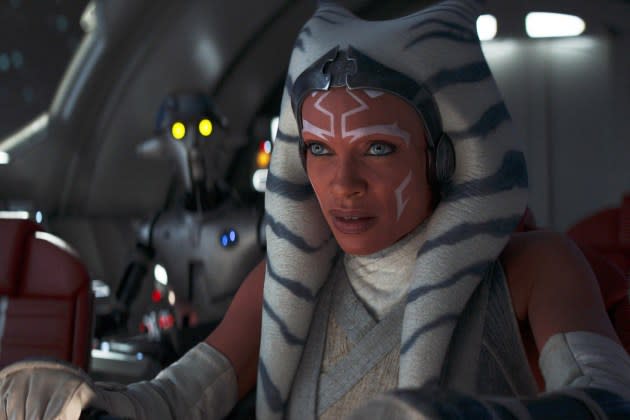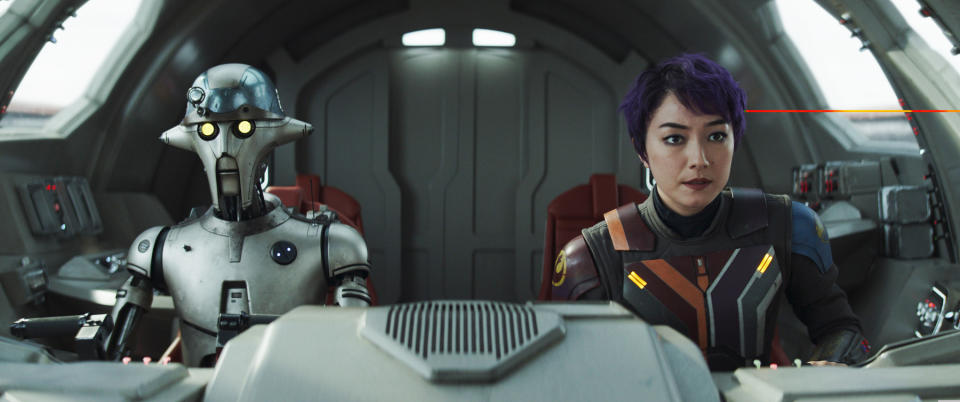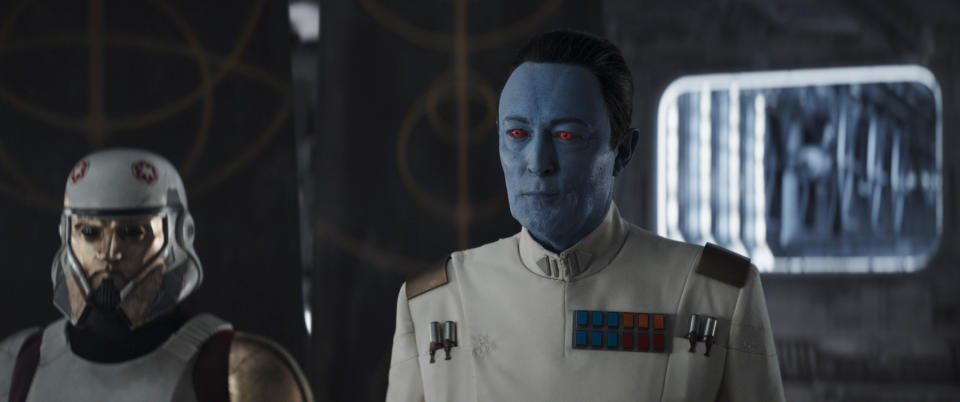‘Ahsoka’ Finale Is a Disappointing End to the ‘Star Wars’ Spinoff
- Oops!Something went wrong.Please try again later.
- Oops!Something went wrong.Please try again later.
- Oops!Something went wrong.Please try again later.
- Oops!Something went wrong.Please try again later.
- Oops!Something went wrong.Please try again later.
- Oops!Something went wrong.Please try again later.
- Oops!Something went wrong.Please try again later.

This post contains spoilers for the Ahsoka season finale, which is now streaming on Disney+.
The Ahsoka finale, “The Jedi, the Witch, and the Warlord,” invites many questions. What exactly is the deal with the zombie Night Troopers? Why would a witch need a sword? What has been motivating ex-Jedi Baylan Skoll? Why does Grand Admiral Thrawn look so much like Elon Musk, when actor Lars Mikkelsen in real life does not resemble the owner of the social media network formerly known as Twitter?
More from Rolling Stone
Most importantly, though, is this: Exactly where does Ahsoka creator/Star Wars TV boss Dave Filoni intend to continue the story?
The finale is a To Be Continued in virtually every sense. Ahsoka (Rosario Dawson), Sabine (Natasha Liu Bordizzo), and Huyang (David Tennant) are trapped a galaxy away from their friends, as are Baylan (Ray Stevenson) and his apprentice Shin (Ivanna Sakhno). Thrawn and his crew have made it back home, and are preparing to set up shop on Dathomir, the homeworld of the Nightsisters. And Ezra (Eman Esfandi), having stowed away on Thrawn’s ship, has reunited with Hera (Mary Elizabeth Winstead) and the rest of the New Republic.
It is in no way a satisfying ending to an eight-episode season of television, unless all you cared about was a glimpse of the Force ghost of Anakin Skywalker (Hayden Christensen) nodding approvingly at whatever emotional journey his former padawan Ahsoka has just gone through. There’s no plot resolution, and barely any thematic closure. But Filoni clearly does not intend for this to be the conclusion to any of the stories. There seem to be four options available to him:
A) A second season of Ahsoka
B) An upcoming season of The Mandalorian, since some of that show’s own ongoing storylines were for some reason wrapped up over on Book of Boba Fett
C) A planned movie written and directed by Filoni that’s meant to tie together the strands of all the TV series that he and/or Jon Favreau have run
D) All of the above
None of the choices are ideal, not least because, between the SAG-AFTRA strike and the complexity of producing these stories, it could be a couple of years before we see Ahsoka and company again, under any title. There also aren’t official orders yet for Ahsoka Season Two or Mandalorian Season Four, though Favreau says he’s already written the latter, and it’s hard to imagine Disney+ not ordering at least one of those, if not both. Even the movie isn’t guaranteed to happen, given how many Star Wars films have been announced and then abandoned in the years since Rise of Skywalker.
But while we can assume that the plot will continue somewhere, it’s terrible messaging to give viewers — whether Star Wars obsessives or casuals — no word on when, how, or even if this will happen. In contrast, the Disney+ Marvel shows often end with text saying where the main characters will appear again within the larger MCU. The Filoni/Favreau series, on the other hand, have been more muddled on this front. Mandalorian Season Two ended with a note promising that Boba Fett would return in Book of Boba Fett, but did not prepare anyone for the idea that significant Mandalorian events would happen on the spinoff. And the next Mandalorian season in no way attempted to explain the details of Mando and Grogu’s reunion. There weren’t even clips of it in the premiere’s “previously on” montage.
You could perhaps compare the Ahsoka finale to The Empire Strikes Back, which also concludes with our heroes in various states of limbo, and the villains ascendant. But audiences in 1980 knew that another movie was definitely in the works, and Empire told individual character stories about Luke, Leia, and Han that were satisfying even within the context of a story where our heroes lost every battle.

“The Jedi, the Witch, and the Warlord” was less successful on that front. Some ideas from the season paid off, like Sabine successfully using the Force to retrieve her lightsaber and then help Ezra jump onto Thrawn’s ship. Many others, like Baylan’s quest for … something, did not(*).
(*) This was perhaps the most egregious instance of Ahsoka making Filoni’s animated series into required reading. The statue we see Baylan standing on is in the likeness of the Father, the all-powerful figure who is perhaps responsible for the Force itself. But the Father and his children (one representing the light side, one the dark) were introduced in a Clone Wars episode that first aired a dozen years ago. If you don’t remember what Father looks like, much less who Father is, it’s a meaningless piece of spectacle. There’s also the sad fact that Ray Stevenson died after filming on this season was complete. So either the role gets recast, the explanation for what Baylan was doing somehow gets reassigned to Shin, or the subplot gets dropped altogether. Again, it’s a list of suboptimal choices.
Mostly, though, there is Ahsoka herself. At times, she seemed to be playing second fiddle to Sabine in a show where she’s the title character. Since Sabine had an interesting character arc, that’s not a huge issue. It’s more that Ahsoka’s own story seemed meandering and underfed. She begins the series guarded and bitter, reluctant to be around her former student, focused entirely on finding Ezra and stopping Thrawn. Midway through the season, she appears to have been killed by Baylan, and winds up in the World Between Worlds, a mystical plane introduced in Rebels. There, she’s forced to duel Anakin, and to relive battles she experienced as a girl during the Clone Wars. It’s a familiar type of episode from sci-fi/fantasy series. (More down-to-earth dramas accomplish the same thing through dreams and/or therapy scenes.) But it’s never made clear exactly what lesson she’s learning, nor why Anakin keeps asking if she wants to live or die, when we know going in that it’s the former. Ahsoka is goal-oriented and has no death wish. The whole thing felt like a first draft of this kind of story that never got polished, or like all Filoni was concerned with was giving us live-action glimpses of the Clone Wars, and letting Christensen play a less-annoying version of Anakin than the one in the prequel films. Ahsoka returns to life as a more serene and happy figure, and Dawson’s performance becomes much more appealing and nuanced after that. But there’s no real effort made to explain or compellingly dramatize the emotional trip from Point A to Point B.
The rough-sketch nature of the storytelling was palpable throughout these eight episodes. Characters spoke very… slowly… in between lines of dialogue… and even… in the middle… of lines. These pauses were perhaps meant to give greater dramatic heft to what was happening, but they instead sucked the energy out of scenes, and felt like they were trying to compensate for what wasn’t there in the scripts. The emotions also felt muted to the extreme throughout. Sabine cares so much about Ezra that she is willing to risk freeing Thrawn and allowing the Empire to rebuild. Yet when she finally reunites with her old friend, it plays more like she’s at Trader Joe’s running into someone who was her lab partner for a week in AP Chemistry.
The season also struggled to establish Thrawn as a big bad worthy of all the hype, and of the possibility of being the main villain in upcoming shows and/or movies. If you watched Rebels, and/or read the books that introduced Thrawn, you know that his distinguishing attribute is being smarter and less prone to overconfidence than other Imperial leaders like Grand Moff Tarkin. He recognizes the threat that Ahsoka poses to his escape, for instance, but also knows that all he has to do is slow her down. These episodes didn’t do a great job of turning his calculating nature into interesting drama, as he spent most of the time staring at holographic maps of the planet and getting reports of what his Night Troopers(*) were up to.

(*) There’s also no real explanation given for why the Troopers have remained so fanatically loyal to him even after he got them stranded so far from home, in such a hostile environment. In a longer season, there might have been room for an episode like “The Other 48 Days” from Lost, where we see what life has been like for the crew in the years since Ezra trapped them here, and the events that have made them more devoted to Thrawn than ever.
The finale at least picks up the pace, with a number of lively action sequences pitting our heroes against TIE fighters, Night Troopers both living and undead, and the doomed Morgan Elsbeth (Diana Lee Inosanto). Even that had some rough edges, though. After Ahsoka and friends kill a roomful of Night Troopers, Morgan casts a spell reviving them in zombie form. But there’s no rhyme or reason to how these zombies behave, nor to how many Troopers total have been affected by the spell. At first, it seems like only these dead soldiers have been zombified, but soon it appears to be all the ones remaining on the planet’s surface. Sometimes, they shuffle along like they’re from The Walking Dead, and at other points they are sprinting like they’re in 28 Days Later. Some of them can be injured and then get back up, while others are impervious to any harm short of a serious head wound. At times, they relentlessly pursue our heroes; at others, they’re content to stand and watch Ahsoka duel, and then kill, the woman who created them. As with so many other aspects of the series, the zombie business seems to have been conceived with an endpoint that no one worried about properly setting up.
The first season of The Mandalorian, coupled with the hardcore fans’ love of Clone Wars and Rebels, seemed to establish Filoni as the creator best suited to steer the franchise out of an extended rocky period. But the later seasons and shows (not counting Andor, which Filoni didn’t have a hand in) have been uneven at best, genuinely bad (anything on Boba Fett not involving Mando and Grogu) at worst. Ahsoka seems certain that she and Sabine are meant to be stuck in another galaxy for now, and that things will work out for them. It’s hard to feel quite as confident about Star Wars itself at the moment, regardless of where, or if, we see Ahsoka next.
Best of Rolling Stone

